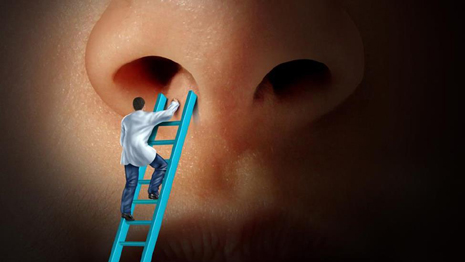“It’s the future of medical testing,” says physician Raed Dweik, who runs the pulmonary vascular program at the Cleveland Clinic’s Respiratory Institute. He and his colleagues are developing a simple breath test to diagnose heart failure. Typically, the diagnosis requires a medical history, physical exam, blood test and electrocardiogram.
Breath testers could “allow earlier diagnosis of disease at a stage when it can be treatable,” says Hossam Haick, of Israel’s Russell Berrie Nanotechnology Institute. Early detection would boost survival rates for diseases like lung cancer, whose symptoms typically don’t appear until an advanced stage.
Heart failure patients could use the test as an at-home monitoring device to confirm whether their fatigue or swollen feet warrant an ER trip.
The potential cost-savings are enormous, too. Haick’s invention, the NaNose, can detect ovarian cancer, Alzheimer’s disease and 18 other diseases with a single screening process. The rough cost could be as low as $5 to $8, a smidgen of the cost of an MRI or CT scan, which can cost thousands of dollars. Breath tests could also spare patients exposure to potentially harmful radiation.
But breath tests aren’t perfect. Many devices are still awaiting FDA approval, and they probably won’t replace traditional blood tests or biopsies. Instead, they would screen high-risk patients who should undergo further testing. “We’re not going to say you have breast cancer or lung cancer based on a single breath test,” cautions Michael Phillips, founder of Menssana Research, Inc.
Here’s why breath tests work: Since the body’s molecules flow through the blood and are exhaled from the lungs, the pattern of so-called volatile organic compounds (VOCs) in our breath can reflect what’s happening elsewhere in our bodies. Kidney disease and diabetes have distinct VOC signatures — they’re so strong doctors can smell them without a detector.
But some devices can smell VOCs that our noses can’t detect. Haick’s palm-sized NaNose works — well, like a super-sensitive nose. Patients breathe into a tube that contains VOC-detecting sensors. The sensors relay the data to a computer that can recognize and interpret VOC patterns. Most tests show breathprints as graphs that require statistical analysis to interpret. Eventually, researchers hope, tests will display a simple red or green light, requiring minimal training to use.
Phillips and other Menssana researchers have devised a similar, six-minute test that detected breast cancer with 80 percent accuracy in a study of 244 women, published in PLOS ONE in March. That means women who test positive should still have other tests, including a mammogram. But the system identified women without breast cancer or an abnormal mammogram result with almost 100 percent accuracy, meaning that those who test negative could safely skip the uncomfortable procedure. Menssana is also developing breath tests for lung cancer, pulmonary tuberculosis and the flu.
The newest breath tests are faster and easier to use, not to mention far more sensitive and reliable.
Dweik’s heart-failure breath test has posted promising preliminary results, too. In a trial of 46 patients, the device correctly identified all those suffering from heart failure — even distinguishing them from those who had cardiac issues, but not heart failure — according to a paper published in the Journal of the American College of Cardiology last year. Heart failure patients, who have a high risk of recurrence, could use the test as an at-home monitoring device to confirm whether their fatigue or swollen feet really are symptoms of heart failure and warrant an ER trip.
Breath analysis isn’t an entirely new concept. Ancient Greek physicians followed their noses to diagnose kidney disease and other ailments, while dogs have been trained to sniff out abnormal blood sugar levels for diabetes patients. Hospitals also use lab-based tests to analyze VOCs in bodily samples, while “first-generation” tests can detect stomach ulcers and other gastrointestinal problems in urine. But the newest breath tests are faster and easier to use, and, compared to dogs and human noses, more sensitive and reliable.
A handful of FDA-approved breath tests for carbon monoxide poisoning, heart-transplant rejection and asthma have already hit the market. But many others still need funding for FDA trials. And some, like Dweik’s, are as hefty as washing machines and need to be plugged into a power source. Dweik expects breath tests to be portable enough to use not only at home, but also in remote, underserved areas within the next five years.
“The real promise — and we’re not quite there yet — is to do point-of care testing similar to how people with diabetes do with glucometers,” he says.
Which means we might all breathe easier, longer.
More about:
















































